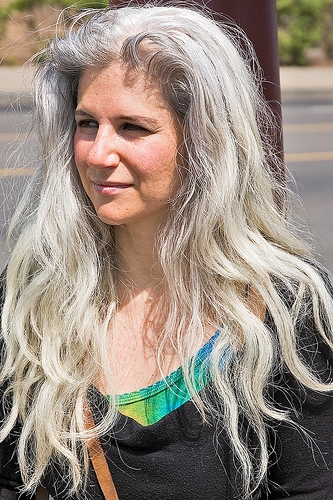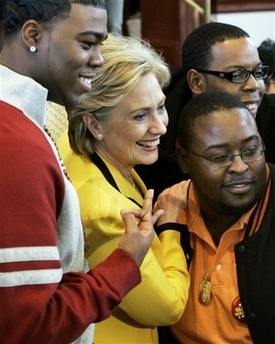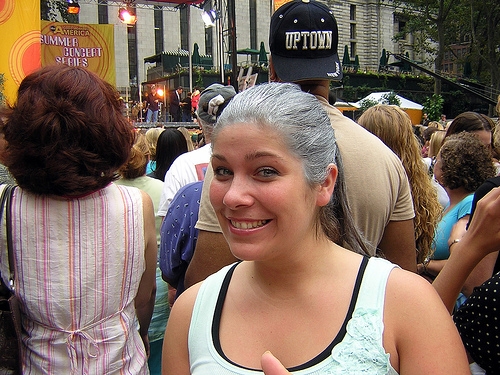Hilary Clinton and Women's Graying Hair



On January 13 of this year, I came across an item in the Winnipeg Free Press about women’s reactions to the way Hilary Clinton’s candidacy was being viewed by a big section of the American electorate.“You want to criticize her policies, her voting record or her platform, go ahead. Her hairstyle, weight, wrinkles and style of dress are off limits,” wrote Lindor Reynolds of Winnipeg Free Press. It was not just this item that I stumbled upon about people’s perception of Hilary and her hairstyle which includes, of course, her graying hair. There was one article that said about a survey on American voters if Hilary, with her graying hair, would stand a chance as the next US president.
Come to think of it, this is not just a woman next door in the public eye. This is Hilary Clinton, former US First Lady. Why it is that her gray hair is being talked about in her candidacy speaks about people’s perception of gray hair not only in the world’s richest and most powerful country but also in poor countries on earth.
Indeed, the part of the body that has always been the subject of adornment and social functions is the hair. The headgear, closely related to hair styling and later to hair color, has been a part of humanity’s rituals since the dawn of human history. Outside of adornment which ranged from the ornately curled blond wigs of Roman matrons to the bob and shingled hair of the 1920’s, the multi-colored hair of the late 1990’s to the everything-goes-hair- style of our present era, the element of adornment, economic and social status are still present. The mainstream perception, however, that this or that group should do its hair according to how it is perceived, justifies stereotyping. Putting people in a certain type of configuration, or making a template of particular groups would have helped understand identity. But the problem with simplifying the concept of identity is that the basis of defining identity is still the theory of individual differences. Each person is unique. Each group is unique. Each person or each group does not have an entirely similar set of indicators in defining a given reality.
Let’s take for instance the subject of gray hair. There’s nothing wrong with gray hair. Graying is part of the natural season of age that to put it in the landscape of economic and social pressures is to put aging in the arena of conflicting interpretations. People who are in the hair dye industry, for example, would define grooming as well-dyed hair. Gray hair would not be viewed kindly, much less accepted. On the other hand, people who are in the realm of good health and wellness would define grooming as healthy and shiny natural hair. In the real world, however, the latter are sometimes overruled by the former and the struggle for interpretation on the value of black and gray hair continues.
There is also the issue of ageism. Not many will accept openly to being ageist but when you are sixty and you are praised for your age and not for your credentials you are in the lair of ageists. If your gray hair is frowned upon instead of being viewed as a symbol of wisdom and triumph over the many vicissitudes of life that you have been through, you are in the trap of ageists. When people show surprise that you are still strong at sixty and don’t look sixty, you need to watch out. You are in the circle of ageists because why should there be a fixed look for 60’s or any age for that matter.?
Being anti-ageist is not about creating myths over the realities of ageing. When “senior moments” set in at 80 or 90, you take memory problems as part of the wear and tear of the nervous system. This acknowledgment of the physiological aspect of ageing is not the same as looking down on the elderly for not being “performing assets” anymore. Ageism is consciously excluding older persons from social interactions or discriminating against them on the basis of their age and the ugly stereotypes created around ageing by a market-oriented world view. Being driven to look young to the point of compulsion and therefore having to value only things related to being young thus relegating the things related to old age as things that have to be abandoned and deliberately overlooked is ageism at its core.
Ageism has no name. No one will confess to being an ageist but we live in an ageist society. People often refer to your age when you achieve instead of focusing on your achievement. People are not just being discriminated against for being old. They are also discriminated against for being young. When people exclaim: “You are too old to be in school” or “You are too old to be the president of the Parent-Teacher Association or “You are now a senior citizen and must pay attention to the way you behave” ….These are not simple words. These are lines of discrimination and exclusion
Why is society so obsessed with linear time – that idea that time is divided into past, present and future and outside of such horizontal flow is nothingness? Programming society’s consciousness into a belief system that compartmentalizes the past, the present and the future is partly the answer to how mainstream thinking views age. The concept of “dreamtime” by the Indigenous People of Australia is a strange concept if located in the paradigm of linear time. According to Jean Dixon, author of the book “The Mythical Life,” “dreamtime” is past, present and future flowing into one another such that the past is not strictly past and the future not strictly future. With the “dreamtime” concept, fear of ageing is an idea that doesn’t exist.
The concept of “dreamtime” may very well be the alternative to people’s fear of ageing. At the bottom of this fear is really fear of death or fear of one’s final end. But in “dreamtime,” it’s only one’s body that follows the seasons and therefore returns to the soil. In “dreamtime” it’s just the human shell that dies but the spirit lives through infinity. The concept of “fractals” or being part of the whole emphasizes the meaning of continuity. In the “dreamtime” paradigm, gray hairs are not negative symbols.
The fact that people commented on Hilary Clinton’s hair style which included her gray hair during the campaign period for the primaries in the US was not just about the American electorate making a statement on age. It was also about a prevailing world view that uses a double standard in passing judgment on women. Men are not judged harshly on the aspect of graying hair. But then again, perceptions change over time.
Below are photos of lovely women with gray hair, courtesy of Collective Commons' Photo Service.





